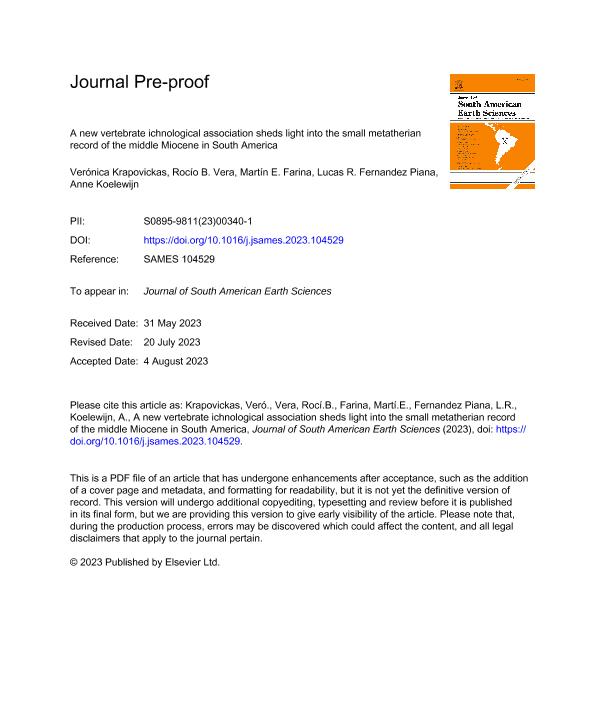Mostrar el registro sencillo del ítem
dc.contributor.author
Krapovickas, Verónica

dc.contributor.author
Vera, Rocío Belén

dc.contributor.author
Farina, Martin Ezequiel

dc.contributor.author
Fernandez Piana, Lucas Raul

dc.contributor.author
Koelewijn, Anne
dc.date.available
2023-09-27T16:32:44Z
dc.date.issued
2023-09
dc.identifier.citation
Krapovickas, Verónica; Vera, Rocío Belén; Farina, Martin Ezequiel; Fernandez Piana, Lucas Raul; Koelewijn, Anne; A new vertebrate ichnological association sheds light on the small metatherian record of the Middle Miocene in South America; Pergamon-Elsevier Science Ltd; Journal of South American Earth Sciences; 129; 9-2023; 1-75
dc.identifier.issn
0895-9811
dc.identifier.uri
http://hdl.handle.net/11336/213275
dc.description.abstract
Vertebrate ichnological associations recorded in Middle Miocene successions were unknown in South America. During that time, South America was isolated from other continents and had a unique endemic fauna and flora. The lower Vinchina succession occurred between 15.6 and 12.7 Ma and records the footprints of highly specialized mammals, reptiles, and birds for the first time. To identify all footprint producers, we focused on anatomical traits of the appendicular skeleton represented on the footprints together with body size estimations of the producers as body mass and the apparent trunk length (GAD). Carnivoripeda sudamericana nov. isp. reveals a weasel-like producer of ∼1 kg and a trunk length of 19–26 cm most likely attributed to metatherian carnivores (Sparassodonta). They represent the oldest carnivore footprints in South America. Small bipedal rodent-like mammals of ∼280 g using a jumping gait (Morphotype A) are interpreted as produced by highly specialized South American marsupials, argyrolagids, whose footprints were unknown until now. Other mammalian footprints recorded are Tacheria troyana most likely produced by dinomyid caviomorph rodents. They represent animals of ∼16 kg and a trunk length of 48–55 cm, like living dinomyids. Subcircular to oval structures (Morphotype B) seems to be produced by medium-sized ungulates, while stepping in cohesive and plastic soupy sediments. cf. Chelonipus torquatus suggests small freshwater turtles (Chelidae or Podocnemididae), of ∼400 g consistent with a trackmaker of carapace size of ∼9 cm. Aviadactyla vialovi was most likely produced by a small shorebird (Scopolacidae) of ∼40 g. All footprints are preserved on crevasse splay deposits of anastomosing fluvial systems together with meniscate feeding (Taenidium barretti) and simple dwelling trace fossils (Palaeophycus tubularis) produced by insects and are an example of the Scoyenia Ichnofacies.
dc.format
application/pdf
dc.language.iso
eng
dc.publisher
Pergamon-Elsevier Science Ltd

dc.rights
info:eu-repo/semantics/openAccess
dc.rights.uri
https://creativecommons.org/licenses/by-nc-sa/2.5/ar/
dc.subject
ARGYLOLAGIDAE
dc.subject
CHELIDAE
dc.subject
DINOMYDAE
dc.subject
PODOCNEMIDIDAE
dc.subject
SHOREBIRDS
dc.subject
SPARASSODONTA
dc.subject.classification
Paleontología

dc.subject.classification
Ciencias de la Tierra y relacionadas con el Medio Ambiente

dc.subject.classification
CIENCIAS NATURALES Y EXACTAS

dc.title
A new vertebrate ichnological association sheds light on the small metatherian record of the Middle Miocene in South America
dc.type
info:eu-repo/semantics/article
dc.type
info:ar-repo/semantics/artículo
dc.type
info:eu-repo/semantics/publishedVersion
dc.date.updated
2023-09-25T14:33:33Z
dc.journal.volume
129
dc.journal.pagination
1-75
dc.journal.pais
Estados Unidos

dc.description.fil
Fil: Krapovickas, Verónica. Consejo Nacional de Investigaciones Científicas y Técnicas. Oficina de Coordinación Administrativa Ciudad Universitaria. Instituto de Estudios Andinos "Don Pablo Groeber". Universidad de Buenos Aires. Facultad de Ciencias Exactas y Naturales. Instituto de Estudios Andinos "Don Pablo Groeber"; Argentina. Universidad de Buenos Aires. Facultad de Ciencias Exactas y Naturales. Departamento de Geología. Laboratorio de Paleontología Evolutiva de Vertebrados; Argentina
dc.description.fil
Fil: Vera, Rocío Belén. Consejo Nacional de Investigaciones Científicas y Técnicas. Oficina de Coordinación Administrativa Ciudad Universitaria. Instituto de Estudios Andinos "Don Pablo Groeber". Universidad de Buenos Aires. Facultad de Ciencias Exactas y Naturales. Instituto de Estudios Andinos "Don Pablo Groeber"; Argentina. Universidad de Buenos Aires. Facultad de Ciencias Exactas y Naturales. Departamento de Geología. Laboratorio de Paleontología Evolutiva de Vertebrados; Argentina
dc.description.fil
Fil: Farina, Martin Ezequiel. Consejo Nacional de Investigaciones Científicas y Técnicas. Oficina de Coordinación Administrativa Ciudad Universitaria. Instituto de Estudios Andinos "Don Pablo Groeber". Universidad de Buenos Aires. Facultad de Ciencias Exactas y Naturales. Instituto de Estudios Andinos "Don Pablo Groeber"; Argentina. Universidad de Buenos Aires. Facultad de Ciencias Exactas y Naturales. Departamento de Geología. Laboratorio de Paleontología Evolutiva de Vertebrados; Argentina
dc.description.fil
Fil: Fernandez Piana, Lucas Raul. Consejo Nacional de Investigaciones Científicas y Técnicas; Argentina. Universidad de San Andrés; Argentina
dc.description.fil
Fil: Koelewijn, Anne. Universitat Erlangen-Nuremberg; Alemania
dc.journal.title
Journal of South American Earth Sciences

dc.relation.alternativeid
info:eu-repo/semantics/altIdentifier/url/https://linkinghub.elsevier.com/retrieve/pii/S0895981123003401
dc.relation.alternativeid
info:eu-repo/semantics/altIdentifier/doi/http://dx.doi.org/10.1016/j.jsames.2023.104529
Archivos asociados
